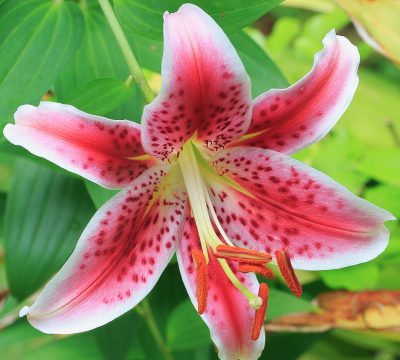Botanical Beauty—For Women Only
August 31, 2022By Tom Poland
What’s behind a name? Lots most of the time. Sometimes it’s obvious, sometimes it’s a mystery, but often it’s botanical. I’ve not met a woman named Star. Nor have I met one named Gazer, but Star Gazer? That’d be a name for the ages. Envision a prepossessing woman training her telescope on a galaxy, that astronomical hoard of raging gas and dust.
Closer to home, curiosity got the best of me, as it often does, and I set out to learn about women-flower names, not flower-women names, mind you. A flower-woman sells flowers. Imagine a street corner, where a woman pedals petals.
A woman-flower carries the name of a flower and flowers come in all shapes, colors, and temperaments. Women comprise humanity’s flower garden, do they not?

Stargazer Lily: botanical beauty.
Of course they do, and some names bring flowers to mind at once: Rose, Ivy, Violet, Lily, Hazel, and Daisy, for instance. Other names surprise you. Erica comes from heather, the Ericaceae family. Daphne is Greek for laurel.
Some names mystify. Desdemona means “afraid of God,” and some women take their name from the Desdemona rose. Desdemona, it sounds exalted and a tad sinful. And here’s a name that sweetens the air like heady perfume, Esmeralda, Spanish for a family of coveted orchids. There’s Rhoda. Named for the rhododendron you ask? No, named for Rhodes, the Greek island first named after its roses. And Daphne, a flowering shrub.
And what about the perilous flowers whose deadly blooms can transport you across the river Styx? We have Amaryllis belladonna. Belladonna, Italian, means beautiful lady, but it’s known as deadly nightshade, and from it we get lethal atropine. During the Renaissance, Italian women used belladonna to enlarge their pupils. They considered big dark eyes alluring. I suspect some cheap sunglasses in all that Italian sunshine would have come in handy. The next time the eye folks dilate your eyes they’ll probably use atropine sulfate drops. I don’t know if it will enhance your allure ladies, but you’ll need sunglasses for sure.
Carolina Jessamine, one of the deadliest flowers, contains neurotoxic alkaloids that affect nerve endings and cause paralysis, muscle weakness, and spasms. All parts of the plant are poisonous, flowers and roots especially. The list of toxic flowers is a long one, both floral and human.
Literature makes good use of flowers to convey women as ravishing, radiant, youthful, and pleasurable. Women as flowers? I suspect as close as they come is to look like flowers. They clothe themselves with floral patterns. They wear flower hairpins, floral jewelry, and flowers in their hair. Remember Scott McKenzie’s hippie anthem? “If you’re going to San Francisco, be sure to wear some flowers in your hair.” (Be sure they’re not toxic.)
You’ll find a few flower names for men, Sorrel, Thorn, and Jared, but they don’t ring poetic as women-flower names do. I know of no men who take their names from pollinators, but women take their femaleness from flowers, and many a botanical beauty flourishes in our garden. And yet how futile to wish humanity’s flowers forever bloom, for the seasons turn and a killing frost always comes. Flower names endure, however, and the list goes from A to Z. There’s Azalea, Alyssa, Aster, Clementine and Iris to Marguerite and on to Zinnia, pretty maids all in a row.
So, ladies, your name, is it floral? If so, which flower might you be? Are you pleasing and fragrant or toxic and bitter? The fore I’m certain.
Visit my website at www.tompoland.net
Email me at [email protected]














